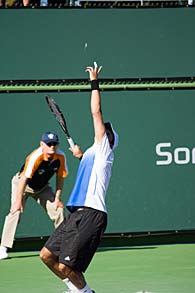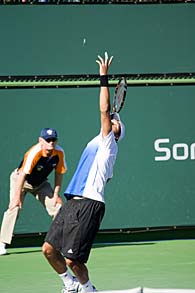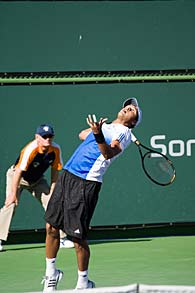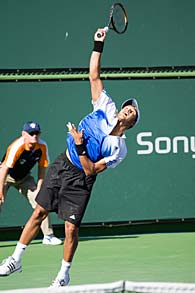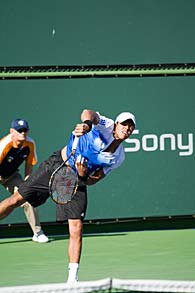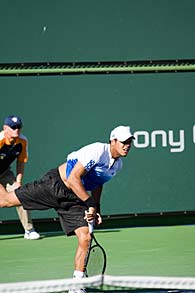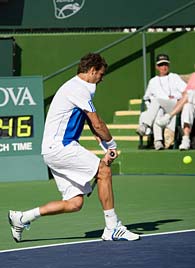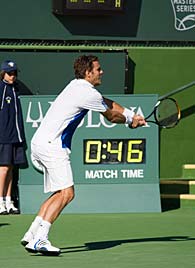|
TennisOne Lessons Ale’ France – Gasquet, Tsonga, and Mathieu Davis Cup Showdown in April This week at the Pacific Life Open, I was on court and watching first hand as Richard Gasquet cruised past Juan Chela and then Jo-Wifried Tsonga struggled mightily before besting country man Paul-Henri Mathieu. Interestingly, this trio boasts ATP rankings of 8th – Gasquet, 14th - Mathieu and 17th – Tsonga. And yes the American Davis Cup team now defends their title, and yes on paper the United States is definitely favored – but these Frenchman can play, and more importantly they play hard court tennis. Perhaps Gasquet and Tsonga appear more comfortable when moving forward to command the point from the net, but this will not be a simple situation where the Americans choose a fast court to play against European clay court experts. And there is a story within that as well. Some years back I read of a striking contrast between the Spanish and French Federation development programs. Whereas the Spanish favored the bruising, semi western, baseline game, and certainly Nadal, Moya, Ferrero and others typify that game, the French, by contrast, were developing all court players with greater variety of grips and court positioning. But when considering how many Spanish players have dominated the French championships at Roland Garros, and we must go back to 1983 when Yannick Noah captured this revered title, interestingly most of the courts in France are hard courts. So perhaps it is quite simple, the French system attempts to produce all court players. One must only reconsider Gasquet’s dramatic victory over Roddick at last years Wimbledon, or Tsonga’s thorough all court victory over Nadal at the 2008 Australian Open to know that these guys can play, and play quite well on hard courts. Richard Gasquet Richard Gasquet has cracked the top ten; in 2007 he held wins over Djokovic, Blake, Roddick, and Ljubicic. Possessing a beautiful, swooping one handed topspin backhand, as well as a wicked knifing under spin from that wing, Gasquet appears equally comfortable from the baseline, playing well behind the baseline on defense, but importantly he moves forward with confidence, and finishes at the net. In his third round match against Chela, Richard played from all corners of the court, offense, defense, chip and charge, under spin finesse, topspin half volley backhand passes, and a 137 mph service bomb. Yes, he was handled with relative ease by James Blake in the fourth round 6-4, 6-2, but this kid has all the tools and appears to be steadily gaining confidence and winning results.
As regards fluid grip changes, and this may be part and parcel of the French system that allows if not enables all court play, Richard plays with a full eastern backhand grip on topspin drives, but equally an eastern forehand grip on his forehand wing, and this grip fluency creates a simple transition when moving forward. Whereas Roddick uses a continental grip on his one handed under spin backhand, and this grip and technique advertises to the opponent that Roddick will routinely play this shot cross court, Gasquet plays with genuine variety playing the topspin one-hander crosscourt or up the line, and equally when changing to the under spin (with a subtle grip change to the continental side) he can fade the ball deep, drive it low, or finesse delicate droppers from that wing. Jo-Wilfried Tsonga Jo-Wilfried Tsonga, riding the momentum from his incredible run to the Australian Open final, plays an all court game with more emphasis on pin point serving, incredible court coverage, and a crushing forehand when moving forward. From a teachers perspective, and I am always looking for elements of technique that young (or eager old) players can study and mimic, this guy has an extremely simple serve. Not huge at the Roddick speed range, but deadly accurate, into the corners, and in most matches his serve improves as the match continues. As to technique, and the following sequential photos clearly support, no one element appears to overwhelm any or all of the others. He tosses the ball slightly out in front, as he simultaneously initiates his shoulder turn away from the hit. He uses a relatively low toss without the unfortunate hitch seen when players move their feet and then wait for an overly high toss to descend into the contact zone. Tsonga appears simply to toss it up and hit it.
Is he loose? Absolutely! His arm swings freely and continuously throughout the motion, but in a whip-like rather than muscular fashion. The knee bend is simple and sufficient but really not all that deep. Often a low toss will lead to a low point of contact, but that is not the case here, Jo-Wilfried "serves tall." As the ball reaches it's peak, he explodes up and into the hit with the racquet well extended at impact and of equal importance, his eyes well up at the moment. He doesn't hurl himself into the hit, nor does he finish in a deep crouch, but rather finishes on balance.
Finally, he uses a forearm roll (not a wrist snap) at the top of the swing, which adds disguise to his heavy pin point delivery. He lost in the fourth round of the Pacific Life Open in a close three setter to Nadal, but look for this likeable young man to make his mark on the professional tour. Athleticism, personality, and a winning smile. This guy has it all. Paul-Henri Mathieu
Paul-Henri Mathieu rounds out this formidable threesome. In 2007 he held wins over Gasquet, Ferrer, Ljubicic, Ginepri, Gonzalez and Davydenko. In his third round encounter with Tsonga, Mathieu played primarily from the baseline, moving quickly and with ease, favoring heavy topspin from the forehand and deadly two fisted accuracy from the backhand wing. But as the match progressed, Tsonga’s serve told the tale, Jo-Wilfried served at 82 vs. 41 on first serve percentage, and 60 vs 54 on percentage of second serve points won. Mathieu can and has served better, certainly one doesn't ascend into the top 20 with these type of numbers, and I look for him to serve much better should he receive a singles assignment in the April 11 - 13 Davis Cup match against the US played in Winston Salem. Stay tuned. This could be both great, and thanks to Tsonga, highly entertaining tennis. Your comments are welcome. Let us know what you think about Jim McLennan's article by emailing us here at TennisOne.
|
|||||||||||||

